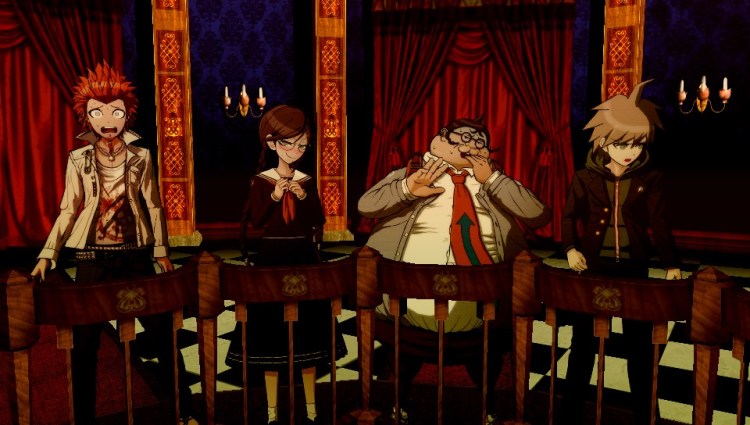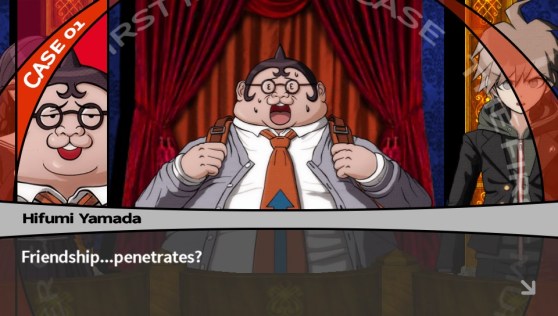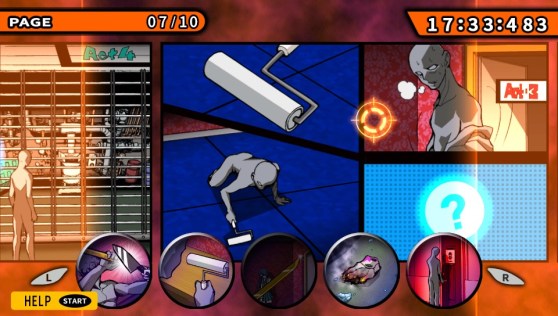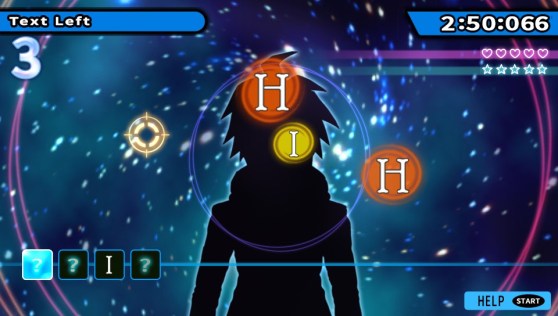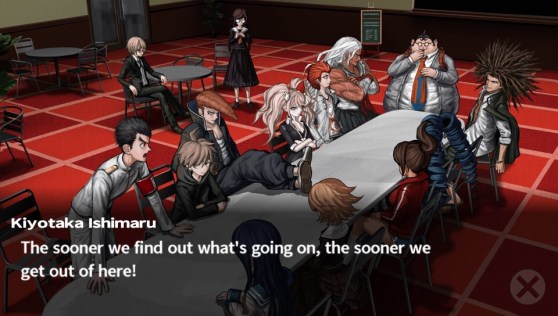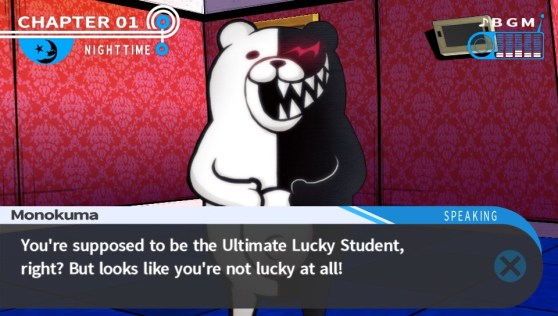Check out our Reviews Vault for past game reviews.
You are one of 15 students trapped in a high school game of murder run by a psychotic teddy bear.
No one can claim that Spike Chunsoft or NIS America is burying the lede with Danganronpa: Trigger Happy Havoc. The high concept insanity of this visual novel/courtroom adventure hybrid (out Feb. 11 exclusively for PlayStation Vita) is made abundantly clear from the prologue going forward. But does this explosion of absurdity have enough appeal to survive beyond the seriously intriguing hook?
What you’ll like
A great set up for a solid routine
Makoto Naegi is the The Ultimate Lucky Student. Randomly selected to attend the prestigious Hope’s Peak Academy, the high schooler barely makes it into the lobby before fainting and awakening in a desperate nightmare. Trapped within the elite school with 15 other “Ultimate” students, Makoto must take part in a lethal game that allows for only one student to “graduate” — and only by getting away with murdering one of their peers. A mysterious entity oversees the game in question, and it interacts with the students through a remotely controlled teddy bear named Monokuma.
It’s a fantastic set up that plays out in a slow burn over six chapters, each running between two to three hours depending on your reading speed. Each chapter begins with exploring any new territory that opens up in the school, gliding a cursor over static backgrounds hunting for interactive objects to further the story or net the odd piece of in-game currency. The next few in-game days are divided into chunks of “Free Time” during which most characters become available for conversations and B-plot development. Inevitably, one of your classmates turns up dead — usually in horrific and oddly specific conditions — and you must begin an investigation with the rest of your peers, collecting all possible clues within the environment before presenting them at a class trial. Your routine hardily varies throughout the game, but it largely avoids redundancy through the strength of the dialogue between characters.
A cast of amiable stereotypes
While only one of the other students — each a leading mind in fields as varied as biker gangs to fan-fiction writing — branches out beyond their initial character archetype, the interplay between them is consistently amusing. A lot of blunt personalities are ramming into each other, but the rivalries and eccentricities are written with a sly flair for personality conflicts (and an abject loathing of the fourth wall). It recklessly satirizes — anime and physical fitness are just two of its targets — and this conversational humor plays well opposite the gruesome story arc.
Nuance may not be a factor in this game of teenage homicide, but that won’t stop most of the deaths from hitting an emotional core. Watching the surviving characters react and form significantly different — and often diametrically opposed — strategies after each murder is Danganronpa’s central charm; especially when it comes soon so after the downright gleeful ways it shows off each esoteric death. The optional but encouraged personal time spent with each character grows into a game of Regifting Bingo, as giving the perfect gift (acquired through a magic prize bubble machine with in-game Monokuma coins) to the right person nets additional skills you can use in the courtroom scenes.
Litigating with bullets
All surviving students adjourn to the courtroom once they complete an investigation and argue over the assembled evidence. Gamers have approached the bench before, primarily through the eyes of Phoenix Wright, but the prosecution process has never been quite as dynamic as it is in Trigger Happy Havoc. At Hope’s Peak Academy, you load evidence into a rhetorical gun as Truth Bullets, and must fire them at contradicting statements from your peers that fly across the screen.
More elements are gradually added to the courtroom with each chapter, but you’ll spend the majority of your time selecting the proper evidence to present and (literally) shooting down lines of logic that contract them. For what amounts to finding the right sentence fragment (highlighted orange against other white text) in a cycle of swiftly scrolling text scrawls, Danganronpa maintains an impressive amount of tension. Each segment is generously timed (at least on Normal difficulty), but it has only a brief window in which to fire at each possible contradiction before you have to start again at the beginning of each phase.
After all the pieces of each case have been presented, Makoto must place the events in chronological order by filling in the narrative gaps of a comic book-style retelling of each murder. Assembling the sequence of events correctly is usually the final step in determining the guilty, or “blackened,” student. Monokuma then drags away culprit for Punishment Time, enthralling and bizarre cutscenes that revel in cruel and unusual death penalties. These vignettes are the guiltiest of Trigger Happy Havoc’s many dark pleasures and the epitome of the game’s delightfully demented approach to death.
What you won’t like
The ever-escalating grind
While everything before each class trial remains interesting through character interaction and plot contortions, Danganronpa’s case-solving mechanics only last a few chapters before growing tiresome. Each murder grows more bloated and complex, the 13 or so phases to each trial becoming a drain on any patience. The brain solves each component of a case within the first few seconds after a phase starts, but the process of finding the exact — and often vaguely worded — contradiction outlasts the thrill of discovery.
Be prepared to develop fidgeting habits as the same text flies across the screen for the fourth time. Mistakes come frequently in Trigger Happy Havoc, more often at the expense of erroneous gameplay obstacles than player error. Purple subtext that appears over contradictions are particularly aggravating, each one having to be tapped aside either by the Vita’s rear touchscreen or the tap of a face button before firing at the proper contradiction.
New mechanics added in later chapters (presumably to combat this exact grind) feel more like busy work than natural gameplay extensions. Hunting for a series of letters to fill in a crucial word makes players effectively stop and solve a junior jumble in the middle of a trial. A final debate with guilty or stubborn characters will frequently play out in a rhythm-based minigame that is somehow equally complex and simple. I managed to beat each one of these “boss battles” by flailing about the controls with little idea of how I survived.
Little sense of agency
It’s hard to feel a sense of genuine accomplishment when solving a puzzle after each you’ve pretty much told where each piece goes. All too frequently in Danganronpa’s investigations, you are so strongly hinted toward the proper line of logic that when a decision finally becomes playable, you have rarely have more than few dots left to connect. You can predict most of the process for each murder before even entering the court room (the game’s attempts at drawing out red herrings is almost endearing in their ineffectiveness,) but as soon as Monokuma’s gavel starts each trial, it doesn’t seem to trust the player to piece things together.
When these sharp nudges come from other characters, it makes enough narrative sense; superior minds are helping Makoto “He’s Just Lucky to Be Here” Naegi-chan solve a murder. But when Makoto himself thinks up a hint just sort of flashing the solution onscreen, even Normal difficulty feels coddling. The game’s hardest difficulty (delightfully named “Mean”) is recommended for most players.
This reduced feeling of agency extends to the less fatal portions of the game as well. A vast majority of the time, Makoto will outright tell you every room you need to visit in Hope’s Peak, and that’s with them all already highlighted on the map. After 13 in-game days of schmoozing with our fellow classmates, we don’t need to be told to head to the dining hall for our post-murder breakfast meeting. The game will also lock you in important rooms during homicide investigations, eliminating any chance of missing a piece of evidence, but dampening any opportunity to flex some detective muscles.
Awkward translation can make things harder
One might think then that Danganronpa is far too easy, with multiple characters practically telegraphing each piece of evidence and the complete impossibility of missing any detail at a crime scene. But several times during each class trial, players will be thrown for such a sudden loop that the only path to progression lies in some serious trial and error. Largely due to the odd translation choice, calls for evidence will be so hazily worded that players will just start picking out objects that only tangentially work with the line of questioning.
The worst offender in this case is the Climactic Inference graphic novel segments. Makoto must choose between two images so similar (like a closeup of a character entering a locker and a long shot of that same character exiting the locker from the same angle) and receives a penalty for having to flip a mental coin. These blips are too random for you to misinterpret as a rising difficulty curve (Trigger Happy Havoc’s challenge picks a level of challenge early on and sticks with it to the stagnant end) and have a habit of showing up just as players are on their last bit of health.
Conclusion
No one takes on a game of betrayal and murder with less comfortable absurdity than Danganronpa: Trigger Happy Havoc. Solving a homicide can be a lot of fun when it’s alongside an idiot clairvoyant, Lolita gambler, and psychotic robo-teddy bear (“Puhuhuhuhuhuhuhu!”). Countering contradictions with metaphorical lead is an amusing attempt to giving a courtroom a more action-packed edge, and it’s a strong enough mechanic to survive some frivolously tacked-on gameplay extensions and hazy road bumps in the translation.
All patient lovers of nerd-dom and the lighter side of death are encouraged to apply to Hope’s Peak Academy. Just remember to pack some heat.
Score: 75/100
Danganronpa: Trigger Happy Havoc releases exclusively for the PlayStation Vita on Feb. 11th, 2014. The publisher provided GamesBeat with a pre-release physical copy of the game for the purpose of this review.
VentureBeat's mission is to be a digital town square for technical decision-makers to gain knowledge about transformative enterprise technology and transact. Learn More
